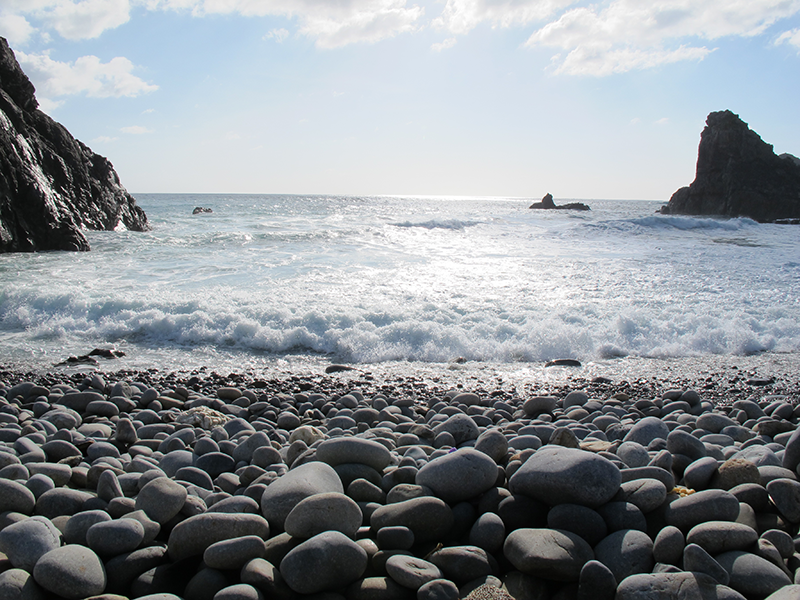Why go abroad when Japan has a tropical paradise on its doorstep?
With Kyoto and Tokyo crowded out, you deserve a place with stunning natural scenery, a unique history, and best of all — hardly any people. Infuse your next journey with a sense of wonder by experiencing a part of Japan that even few Japanese people ever get to see. To do this, go island hopping in the stunning Amami Islands.
But, first things first…
Where and What are the Amami Islands
The Amami Islands is an archipelago consisting of five islands that belong to Kagoshima Prefecture but lie — in almost a straight line from north to south — between Kagoshima and Okinawa. Each island boasts a different landscape and personality, so you can choose the one that suits you best. Do you crave craggy, cave-pocketed coastlines, or flat, white beaches with crystal clear waters? Would you prefer to have an action-packed adventure or would you rather lounge on the beach all day? Regardless of your interests, there’s an Amami island for you.
Dazzling Natural Beauty
The Amami Islands are rich in surreal landscapes of unimaginable beauty and boast impressive biodiversity, with many species endemic to the area. This includes the Amami rabbit, which is often referred to as a living fossil. The islands are also fantastic for whale watching and spotting sea turtles from the shore. As an added bonus, there are virtually no cedar or cypress trees, making the Amami Islands a sanctuary for hayfever sufferers! Many locations are designated as part of Amamigunto National Park, added to the list of Japan’s 34 national parks in 2017. The islands have collectively been granted status as a UNESCO World Natural Heritage Site (Yakushima, Shirakami-Sanchi, the Ogasawara Islands, and Shiretoko have already been recognized) in 2021. This is to ensure the islands’ natural environment is protected for future generations.
Unique Heritage
The Amami Islands have a unique history, even within Japan. Although they were an independent nation at one point, the islands were coveted for their strategic location between the Ryukyu (now Okinawa) islands and Japan’s Kyushu and Honshu islands. The Amami Islands were ruled by both the Ryukyu Kingdom and the Satsuma Domain, then occupied by US forces after World War II. Each period has shaped the Amami Islands’ culture in a different way as it has merged with the locals’ island customs. Famous samurai Saigo Takamori spent some time here too, and many scenes from the 2018 NHK drama Segodon were filmed on location, with several locals taking part in the production.
Getting Around
To get to and between the islands, you can either take a ferry or fly. Flying is the fastest and most convenient if you’re planning on island hopping. For getting around on the islands, car rental is recommended, but all islands offer bicycle rental and most rent out motorcycles as well. Though the Amami Islands may seem far and a little difficult to get to, you’ll be rewarded with views normally reserved for desktop backgrounds and model shoots.
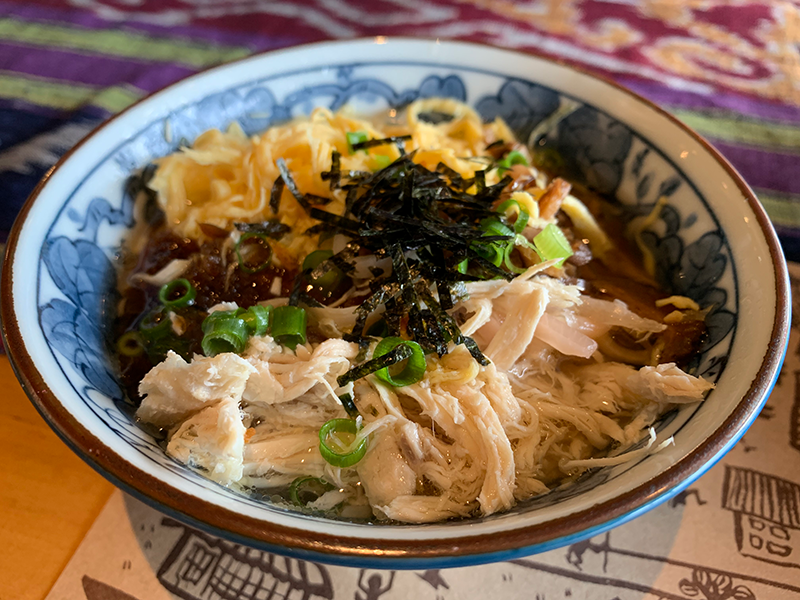
The traditional dish of keihan. Photo by Lisa Wallin
Food & Drink
One of the most famous specialties of the region is kokuto sugar, a cane sugar grown on both the Amami Islands and in Okinawa. This has given birth to kokuto shochu, a crisp and clear spirit that islanders love — and love to share. Each island has at least one famous brand of its own and there are several distilleries open to visitors. As for food, keihan (literally chicken and rice) is a simple but beautifully presented meal that is flavorsome and filling. Ingredients include chicken, shredded omelet, ginger, and a range of vegetables on a bed of rice, covered with a fragrant chicken broth. Each restaurant has its own special recipe, so you’ll never have the same keihan twice (if you don’t want to).
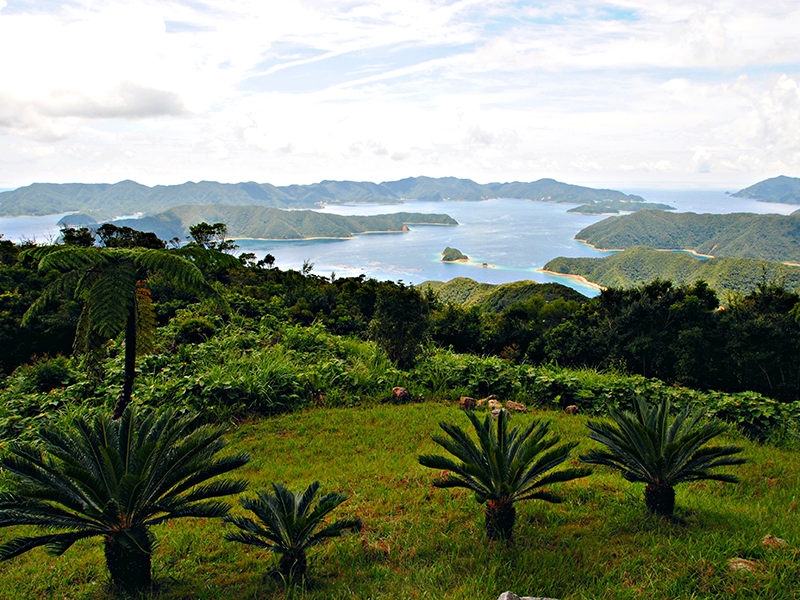
View from Yuidake Observatory, Amami Oshima. Courtesy of Amami Tourism Products & Federation
An Introduction to the 5 Amami Islands
Amami Oshima
Picture velvety green mountains with dense forests dipping into deep blue seas and you have Amami Oshima, the largest of the Amami Islands. Its craggy landscape, borne of volcanic activity, gives the island unrivaled vantage points to look out over the ocean and enjoy the stunning scenery. One of the best spots is Manenzaki Observatory, on the southern tip of the island. From here you can see the colorful coral reefs and sapphire blue waters of Katetsu Bay. For a closer look, book a boat tour to the bay and you may be lucky enough to spot the perfectly circular nest of the Amami pufferfish. This rare species was registered as recently as 2014. Not far from the observatory is Honohoshi Beach, a fascinating stretch of coast where smooth rocks — on average fist-sized — create a thunderous sound as they’re dragged back and forth by the waves hitting the shore. For more of Amami Oshima’s sights and activities, read on below:
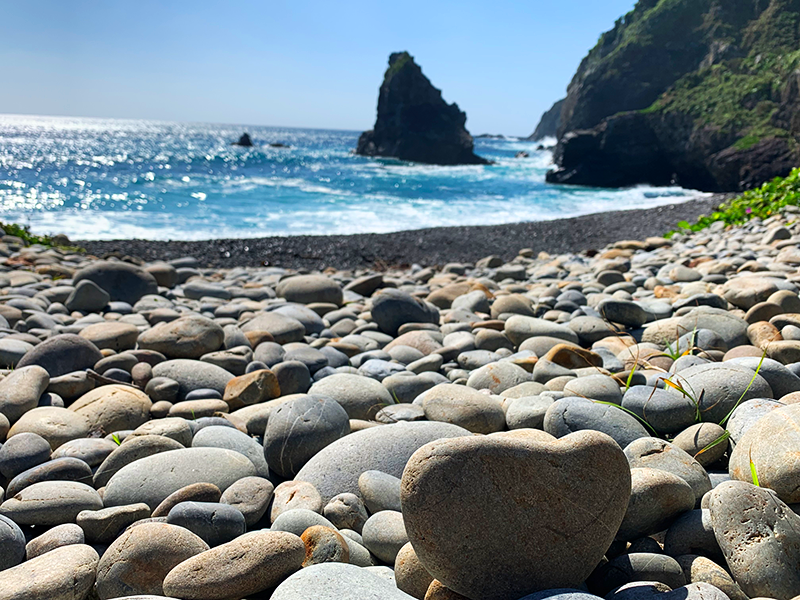
Honohoshi Beach, Amami Oshima. Photo by Lisa Wallin
Our Top Amami Oshima Recommendations
What to Do
Amami Park
This modern facility is located on the grounds of the old Amami Airport and gives a great overview of the Amami Islands’ history, nature, and culture. The complex also houses the Tanaka Isson Memorial Museum of Art, which displays an unrivaled collection of genius artist Isson Tanaka’s vibrant and exotic works.
Oshima Tsumugimura
Here you can learn how sumptuous silk Oshima Tsumugi kimono are made, from dyeing threads in iron-rich mud to weaving complex patterns into the fabric. Its history dates back over 1,300 years and each Oshima tsumugi item requires tremendous amounts of time and careful attention to make. You can also try on an Oshima Tsumugi kimono, experience hand-weaving on a loom, or make your own mud-dyed shirt.
Where to stay
Hotel The Scene — Amami Spa & Resort
Designed by renowned architect Hitoshi Ueda, this exclusive spa resort has only 21 rooms — all of them overlooking the ocean — making it the perfect place to get away from it all. The restaurant serves the finest local ingredients prepared in either a modern Japanese or Italian style for dinner, and if you’re keen on a dip after your meal, head to the resort’s natural onsen — the only one on the whole island.
Where to eat
Basyayama Mura Amami Resort Hotel & Cottage
A complex with a restaurant, shop, multiple accommodation options and a whole slew of beachside and craft activities, Basyayama is a one-stop shop with everything you could possibly need. It also may have the best keihan on the island at its restaurant, which offers a fantastic view of the ocean.
Guides
Amami International Network
AIN has licensed, professional English-speaking guides who are well-versed in all of Amami Oshima’s charms and can tailor tours to your interests. This is your best bet to see Amami’s otherwise hidden charms and rare animals.
Boat Taxi
There are several boat taxis at Setouchi town’s harbor that can be chartered for a couple of hours, half a day or even longer. Let them know what you’d like to do (snorkel, fish, check out the cobalt reefs, hang out on a small uninhabited island for the afternoon) and they’ll be able to recommend the best spots for the day, season and weather.
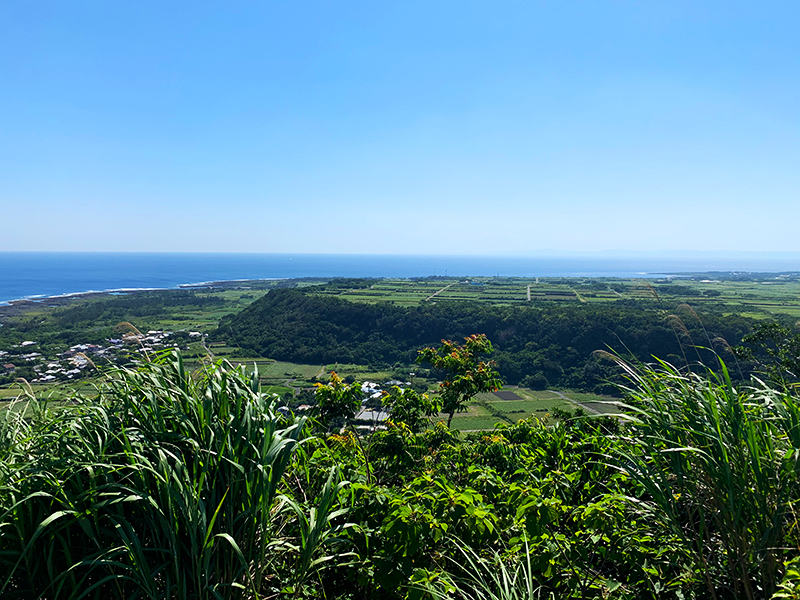
View of elevated coral reef, Kikaijima. Photo by Lisa Wallin
Kikaijima
Head east from Amami Oshima to get to Kikaijima, one of the smallest islands in the archipelago. Though small, this island is well-known in the world of coral science. Kikaijima is an elevated coral reef island and is the second-fastest growing of its kind in the world. Yes, that’s right: The island is growing taller, at an average rate of approximately 2 millimeters a year. It’s one of only three islands in the world like this and it means that you can see 100,000 years of geological history with the naked eye. Simply head to the highest point on the island to view coral reef terraces across the island and try to judge their age. You can also learn more about Kikaijima’s unique structure at KIKAI Institute for Coral Reef Sciences. Kikaijima is the least developed island in terms of tourism, so expect some inconvenience compared with the other Amami islands.

Ogomadara butterfly, Kikaijima. Photo by Lisa Wallin
Our Top Kikaijima Recommendations
What to Do
Aden Community
Walk or cycle through this picturesque residential area lined with coral rock walls. The walls were built to protect houses from strong winds, as well as offer residents some privacy. We don’t recommend trying to drive through, as some streets are very narrow.
Satoukibi no Ipponmichi
Ipponmichi — also known as Sugar Cane Road — is a 2.5-kilometer straight stretch of road lined with sugar cane fields that is great for photos. Pick the highest point here and take a picture to make it look like you’re jumping miles high into the sky.
Where to Eat
Yui Cafe
A stylish shop and café featuring local specialties, this is a great place to get some info for your stay. The Island Juice drink showcases some of the island’s best fruits. Head to the caged area behind the shop to find Kikaijima’s other famous scientific claim to fame: butterflies. Rare butterflies, including the Ogomadara with its golden chrysalises, can be found here. Visitors are welcome to take a look, but make sure to close the gate firmly and don’t touch any of caterpillars, chrysalises or butterflies inside.
Where to Stay
Ikariyama Inn
This inn is close to both the airport and ferry terminal, and offers simple lodgings but at a very reasonable price.
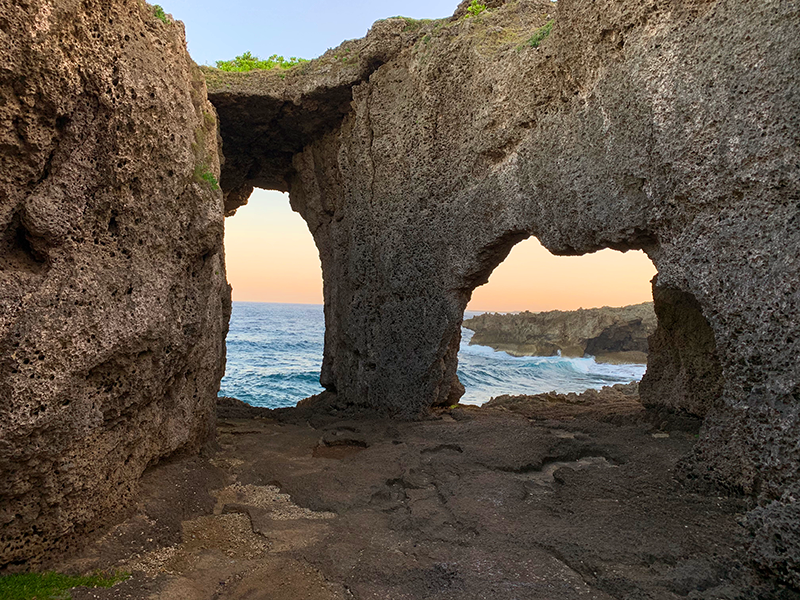
Inno-Jofuta “eyeglasses” rock, Tokunoshima. Photo by Lisa Wallin
Tokunoshima
Tokunoshima is situated in the middle of the five Amami islands and is second only to Amami Oshima in size. Like Amami Oshima, it is of volcanic origin, but being smaller, its rugged landscape feels more condensed. Perhaps this is also why Tokunoshima is considered an island of passion — even the venomous snake habu (only found on Tokunoshima, Amami Oshima and Okinawa) is said to be more aggressive here — as everything feels more intense. It certainly seems so at Mushiroze in the north, where massive rock formations line the coast. See if you can find the shape of a giant turtle, an emperor’s chair or a woman’s profile as you scale the smooth stones weathered by the forces of nature. Head southwest and the coast is completely different — Ryukyu limestone dominates the sea cliffs at Inno-Jofuta, where cave gates in the shape of eyeglasses face the ocean.

The mysterious unbuki cave, Tokunoshima. Photo by Lisa Wallin
What to do
Unbuki
This mysterious cave connects directly to the ocean, which is only 400 meters away from its entrance. However, a professional diving team recently set out to find out exactly where and how the underwater cave meets the sea and found that after 800 meters in, they still hadn’t found an exit — meaning they were already under the ocean bed. You can freely explore the area around the entrance to the cave, which is a place shrouded in myth and whose trees are supposedly inhabited by supernatural spirits.
Cape Inutabu
Listed as one of the Amami Islands’ top 10 most scenic spots, it’s one of the best places on Tokunoshima to watch the sunset. On a clear day, the sun seems to be swallowed up by the sea as it seamlessly slides down beyond the horizon. There is also a memorial for the battleship Yamato here, which was originally thought to have sunk near Cape Inutabu.
Where to stay
Denpaku Accommodation
Denpaku, a combination of the words dento (meaning tradition) and paku (meaning place to stay) are a selection of houses and other structures of historic significance that have been turned into hostels, inns and more for visiting guests. Many of them have fantastic coastal locations.
What to eat
Tamago onigiri
Found at local eateries and izakaya, the tamago onigiri is an example of necessity being the genius of invention. It’s a lightly salted rice ball wrapped in a thin omelet, making it a handy snack when working out in the fields all day. It’s a simple dish that’s great to have on the go, giving a boost of protein and carbs when you need it the most.
Guides
Yuilander Tokunoshima
This is a team of local English-speaking guides who — true to Tokunoshima form — are passionate about sharing their island’s gems with visitors from all over the world. Contact them for a custom-made tour to suit your needs.
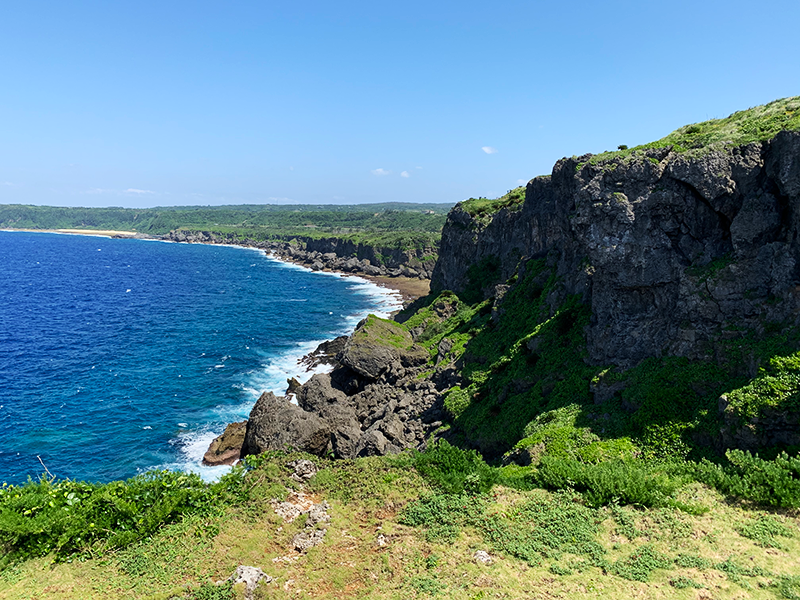
View from Tamina Cape, Okinoerabujima. Photo by Lisa Wallin
Okinoerabujima
Nicknamed the pancake island, Okinoerabujima — simply known as “Erabu” to locals — is, like Kikaijima, a raised coral reef island. Despite its purported flatness, Okinoerabujima boasts dynamic coastlines with high cliffs — such as the 51-meter high Tamina Cape — and the partially collapsed coastline cave at Fucha. The latter offers an awe-inspiring bird’s-eye view over the waves as they crash against the rocks below. Given the island’s coral reef makeup, it’s perhaps no surprise that this relatively small island boasts more than 200 limestone caves. Some of these can be explored together with professional caving guides for an unforgettable underground experience. You’ll come close to giant stalactites and stalagmites that grow at an estimate of only one centimeter every 30 years.
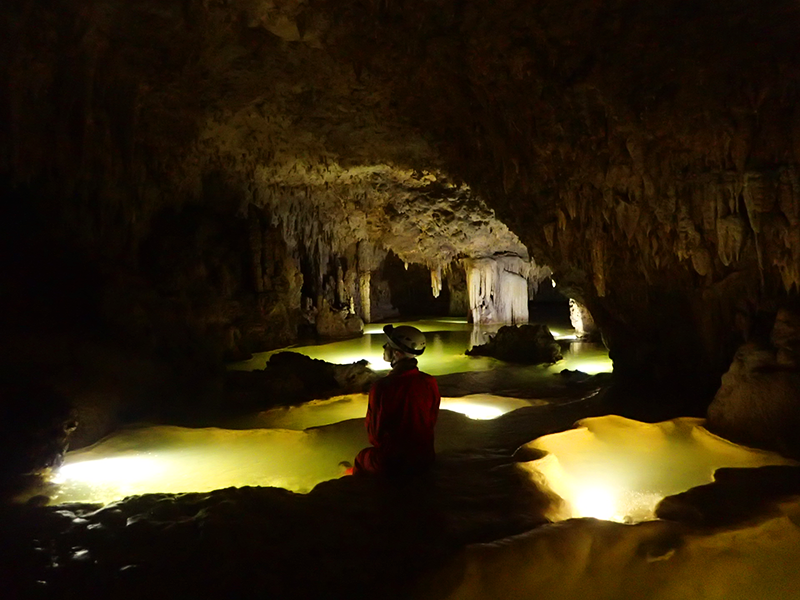
Caving experience in Okinoerabujima. Photo by Kenichi Daito
Our Top Okinoerabujima Recommendations
Where to stay
Kochinda Hotel
A brand new hotel that opened in May 2019, Kochinda Hotel is the epitome of island chic. The bungalow-style building has 12 rooms and though it’s conveniently located in the middle of town, it’s a tiny oasis of greenery and solitude. A banyan tree — a symbol of the island — grows in the middle of the courtyard to give it an additional secluded feel.
Shimayado Atari
Run by Kenichi Daito, one of the caving guides, this cozy inn houses only one group per day. You can also book standup paddleboarding classes here.
Where to eat
Rokkaku-tei Katsuo
Hideki Katsuo serves up delicious island delicacies on a stick at this cozy kushi katsu place that only seats 11 people. The menu is omakase style, but Katsuo is happy to make adjustments according to dietary restrictions. Be sure to list any of these when making your reservation.
Silver Shop Yurari Dokoro
Run by a group of older residents on the island, this charming café serves simple meals and snacks and is a great place to hear stories about the island, pick up some souvenirs, and get recommendations about other places you’d never find on Google.
Guides
IGO (Interpreter Guide association Okinoerabu)
Started recently, this small group of excellent guides will be happy to take you around the island and show you its best sights. Contact igokinoerabu2018 at gmail.com for more information.
Okinoerabu Caving Guide Union
Several guided tours are available, each more difficult than the last. The group recommends starting with the simplest.
GT Divers Okinoerabujima
Former Tokyoites run this diving shop that will open up Okinoerabu’s waters to you.
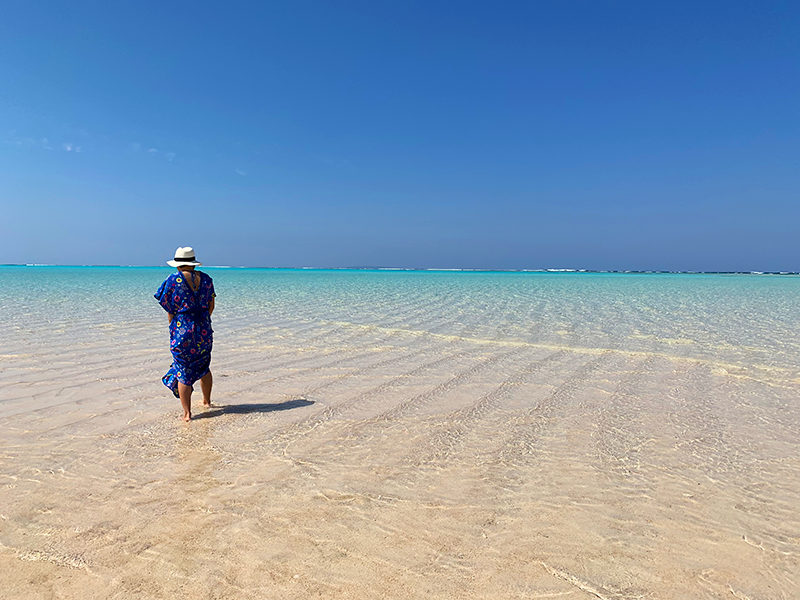
Yoron Island
Yoron Island, or Yoronto, is the southernmost of the Amami Islands, and on a clear day, you can see Okinawa from here. This tiny island is only just over 20 square kilometers. Even so, it boasts almost 60 beaches, meaning that some privacy is almost guaranteed. Yoron is picture perfect with its endless bright white beaches and crystal clear waters — one of the few places in the world that is exactly as advertised. One of the island’s biggest draws is Yurigahama, a sandbank that appears just 1.5 kilometers off the coast of the island at low tide from spring to autumn. Scour this mini beach for star-shaped grains of sand, as it’s said that if you find the same number as your age you’ll be blessed with happiness. To get there, book a seat on one of the many glass-bottomed boats available. Visitors with some knowledge of Greece may find some of the bright white buildings familiar, as there are many charming tributes to Yoron’s sister island, Mykonos, dotted across the island. Also, since Yoron is surrounded by coral reefs, the waters are calm, making them perfect for snorkeling and standup paddleboarding.
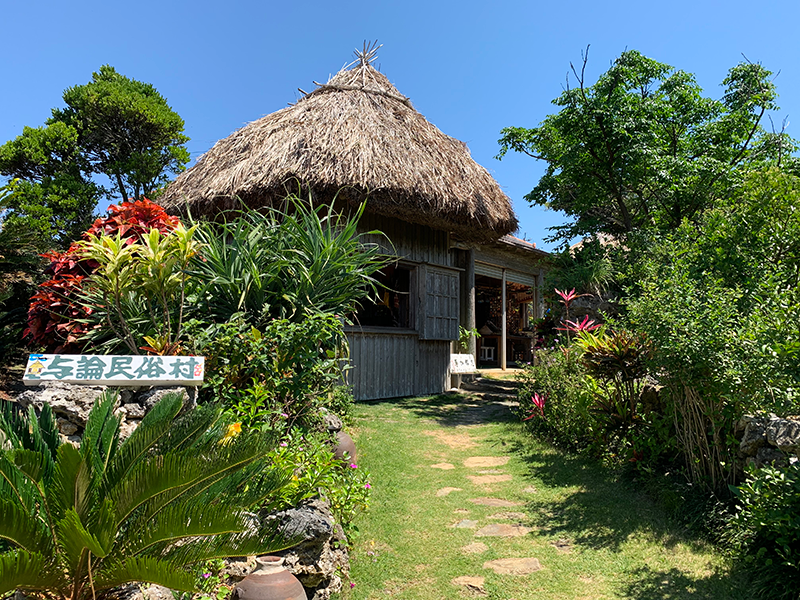
Our Top Yoronto Recommendations
What to do
Yoron Folk Village
This is an open-air museum where you can learn about traditional Yoron lifestyle, and try your hand at making local crafts. Life here was — and still is — different from life on Honshu, so the differences are quite striking.
Southern Cross Center
Rainy days are best spent indoors. Should the weather fail you, head to the Southern Cross Center, which gives a good introduction to Yoron Island culture and includes photos from the island’s past. Drop by Yunnu Taikenkan next door for some craft experiences led by local instructors. Just behind the center, you’ll find the ruins of Yoron Castle that was being built for a Ryukyu prince but was never finished.
Akasaki Limestone Cave
This limestone cave is easily accessible even for kids, so families can enjoy a safe mini caving experience that requires no reservation.
Where to eat
Coffee Stand Nico
Opened in April 2019, this stylish café offers full-bodied coffee, some made using beans grown on neighboring Okinoerabujima. There are lots of freshly baked treats available, with more being added to the menu soon.
Where to stay
Pricia Resort Yoron
Perfect for both families and couples wanting some alone time, Pricia Resort Yoron offers cottages in separate areas depending on your needs. The resort has plenty of daily activities to choose from and also offers its own bicycle and car rental service if you want to explore the island easily. There are several dining options available for dinner, but the best one has to be the outdoor barbecue set, best enjoyed with a sunset and a beer.
How to Get There
You can get to any of the islands by ferry, but it can take forever. The best way to get to (and between) the islands stress-free is to fly.

JAL Group Island Hopping
Whether you want to visit all five of the Amami Islands or you’re happy to stick to one or two, the easiest way to get around is to fly with JAL. The JAL Group offers daily flights to Amami Airport from Haneda, Itami, Fukuoka, Kagoshima, Naha and other airports. There are daily services between the five islands. Some of the flights are so short you’ll get the “we’ll be arriving shortly” message as soon as the plane has reached cruising altitude, making it a surprisingly thrilling experience.
Find out more about the JAL Group Island Hopping experience and read up on JAL’s Guide to Amami Oshima for more information about the Amami Islands. To book a flight with JAL, check out the official website. (Smartphone users please use this link.)
Sponsored Post

